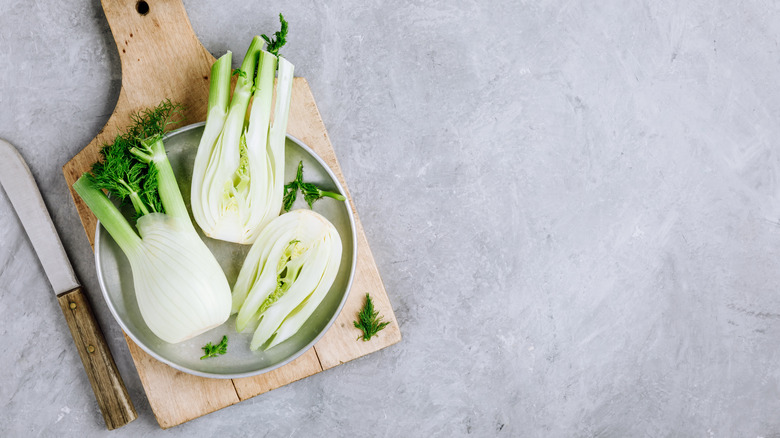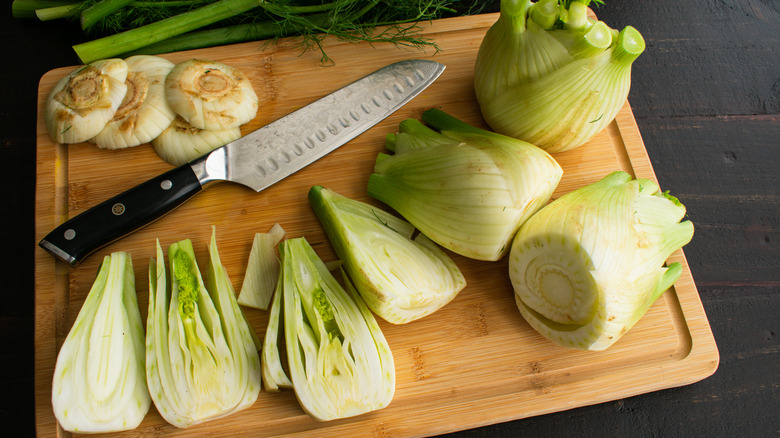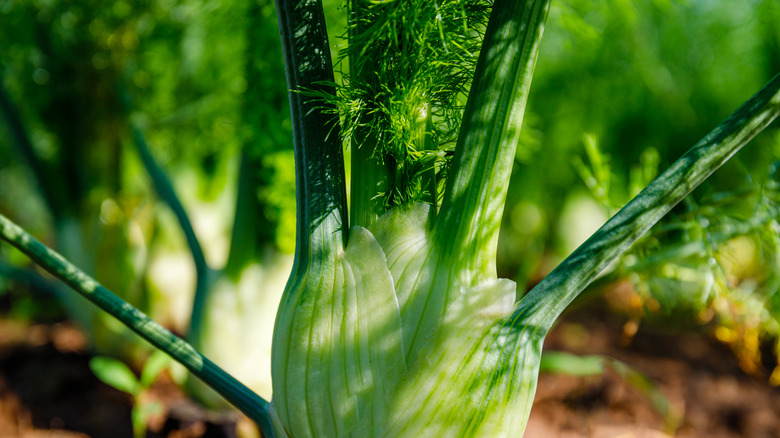The Absolute Best Way To Cut Fennel
For a vegetable with such a distinctive taste, fennel sure is versatile and a real jack-of-all-trades in the vegetable world. Not only does it have a broad range of culinary applications, from being the star in an orange-fennel salad to adding a burst of flavor to tomato sauces, but fennel is also a complex ingredient with a bulb, fronds, and seeds that all have related but distinct features and best uses.
To begin working with fennel, you'll need to know how to prep it since it's an unusually-shaped vegetable with layers like an onion, plus herblike fronds and celery-like stalks. The best way to cut fennel really depends on what you're planning to do with it, but with a little knowledge, you can use one fennel in a plethora of different dishes and culinary preparations.
One tried-and-tested approach to cutting fennel is to start by cutting the stalks and fronds off the bulb and reserving them. Next, slice the bulb in two from the top down through the root, and cut the halves into quarters in the same way, then peel off the outer layers as these can be tough. Then, with each quarter of fennel on its side, chop into slices working from the top end towards the root (reserve this too — nothing needs to go to waste!). The resulting chopped fennel is then ready for several uses.
The many, many uses of fennel
A multi-purpose fennel that's been cut like the one described above can be used in anything from a quick gluten-free snack like lemon coriander fennel bites to a West African chicken and fennel stew. A finer cut is perfect in a base for sauces or in a summer garden soup.
However, many people also enjoy the satisfying, firm-but-yielding texture of fennel on its own. It's best experienced when you cut it, stalks removed, into quarters and then make a braised fennel recipe, grilling it with a little oil over a barbecue or grill.
Another popular cut for fennel is thin-sliced. You can use the largest holes on a standard cheese grater for this purpose, or a mandoline if you have one. Served raw, this delicate cut can make fennel the hero in a vegan carpaccio, a marinated salad, or a classic Italian citrus salad like Finocchi Con Arance, Melagrana E Noci.
Now, back to those leftover fronds and stalks. You can treat the fronds like an herb, which is wonderful as a seasoning for smoked salmon and can also be put to creative use as a drink garnish for a Fennel 75. You can use the stalks (and any other cut pieces) in a stock too; they're equally good as a replacement for celery. Or, you can even chop them, boil them in syrup, and dry them in the oven overnight to create candied fennel.
Tips for buying fennel like a pro
Fennel can be a little pricey, especially when compared to other vegetables with a similar size and texture, such as onions. However, there are reasons to buy fennel that go beyond taste alone. Since they're not related to the allium family (which includes onions and garlic), fennel is a great alternative for those who can't eat onions. A lot of the strong aniseed taste you get from raw fennel will also fade when cooked, so you can swap out onions for fennel bulbs in many recipes. Thanks to their similar textures, you'll hardly notice the difference; in fact, with their delicate cooked flavor, fennel can improve many dishes that originally included onion.
Not all fennel is equal, however. If you're going to buy fennel in a store, you may find it sold with stems and fronds attached, or with these removed so you get only the bulb. If you're planning on getting the most out of this fantastic vegetable, it's recommended to buy ones with stalks and fronds still attached, this way you can make use of all its different parts. In addition, having the stalks attached will also help your fennel to last a little longer when stored in your fridge's crisper drawer. To find out more about how to buy fennel like a pro, here's a handy guide.


